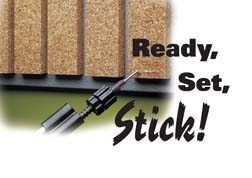
Commonly known as instant adhesives, cyanoacylates have been widely used in assembly processes for the past 50 years. They are single-component adhesive formulations that cure at room temperature, bond to a variety of substrates, and have exceptionally fast cure speeds.
Cyanoacrylate adhesives are ideally suited for bonding applications in high-throughput and fast-cycle-time manufacturing operations. For instance, they are commonly used for bonding loudspeaker components such as surrounds, gaskets, and voice coils and for bonding plastics, metals, and elastomers on disposable medical devices such as catheters and tubesets.
The first cyanoacrylates were predominantly ethyl cyanoacrylate monomer-based materials. They helped many customers realize significant gains in productivity vs. slower curing solventborne, waterborne or multi-component products.
In 1986, the first surface-insensitive cyanoacrylate adhesive (SICA) was developed. SICA formulations used patented technology to improve cure speed on dry or acidic surfaces such as polyolefin plastics, plated metals, wood, paper, leather and cork. The resulting products helped manufacturers increase productivity on an even wider variety of substrates.
Recently introduced next-generation SICA adhesives offer improved shelf-life stability and even faster initial cure speeds than current surface-insensitive technology. Next-generation products maintain performance properties such as cure speed and viscosity better as they age. Therefore, end users enjoy a fast-curing cyanoacrylate product from the first to the last drop in the bottle.

Test Methodology
A comparison test between four next-generation SICA products from Henkel vs. current cyanoacrylate technology from 13 adhesive manufacturers was performed in order to benchmark performance improvements. The objective of the test program was to evaluate the effect of shelf-life aging on product performance. Both accelerated and real-time aging tests were conducted. As the data shows, next-generation SICA products exhibit improved shelf-life stability compared to current surface-insensitive cyanoacrylates.The tested adhesives were selected based upon their overall market share and breadth of their parent manufacturer's product line. Products that were described by product and technical data as "surface insensitive" were selected first. In some cases, products described as "very fast curing," "high performance," or "for difficult-to-bond substrates" were tested. A single adhesive was tested from 13 different adhesive suppliers.
All products were aged and tested in their original containers from the manufacturer. Containers were either 20-gram or 1-ounce bottles or aluminum tubes. All product labels were removed from the packaging to ensure unbiased testing. In addition, every effort was made to obtain the most recent lot of product available along with any support documentation such as certificates of conformance and dates of manufacture.
To facilitate the comparison, all products were grouped into one of four categories based on viscosity: wicking, low viscosity, high viscosity and gel. Comparisons were made only among products of similar viscosity. Wicking grade products were generally less than 20 cP, low viscosity products approximately 100 cP, high viscosity products 300-700 cP, and thixotropic gels packaged in aluminum tubes.
The containers of adhesive were all aged at both room temperature (70°F) and at 50°C. Most cyanoacrylate adhesive manufactures recommend that product be stored in refrigerated (40°F) conditions. While many adhesive distributors do comply, end users rarely do. Therefore, testing at room temperature rather than refrigerated conditions was conducted.
The testing at 50°C was an accelerated aging test with products tested after 0 (control), 2, 4, 6 and 8 weeks of aging. According to the guidelines outlined in ASTM F 1980 for accelerated aging studies, two weeks of aging at 50°C is roughly equivalent to six months of aging at room temperature. The room-temperature test was a real time test with test points at 0 (control), 3, 6, 9 and 12 months. The results presented in this article summarize only accelerated aging testing. The real-time testing is currently ongoing and is scheduled for completion later this year.
Fixture time and viscosity tests compared the performance of the various products. The fixture time test was performed on three different substrates: steel, polycarbonate, and pine. Steel and polycarbonate are common substrates in many cyanoacrylate adhesive applications, and are broadly representative of performance on metals and plastics. Historically, many cyanoacrylate adhesives have achieved very slow fixture speeds on pine, making it an excellent substrate to determine if a product is truly surface insensitive.
Fixture time is commonly defined as the cure time required for a lap shear assembly to support a 3 kg weight. For cyanoacrylate adhesives, fixture time is normally measured in seconds. In this specific test, a bond area of 0.5 square inches was used, which resulted in minimum required bond strength of 13.2 psi. Testing was stopped after five minutes, even if no fixture occurred.
Viscosity measurements were obtained with a Haake RT20 Rotovisco viscometer with a 60 mm cone and plate. The cone and plate type viscometer requires only 1-2 milliliters of product for testing as compared to the 300 milliliters required for a Brookfield type viscometer. The cone and plate were washed with a phosphoric acid solution to prevent curing during testing.

Results
The cure speed performance of four different gel cyanoacrylates was evaluated on steel specimens in one portion of the test program. As the data in Figure 1 shows, the next-generation SICA provided the fastest initial fixture time. Fixture speed increased slightly throughout the eight weeks of aging. The closest performing product (Manufacturer K) had an initial fixture speed of 33 seconds, compared to five seconds for the next-generation SICA. At the end of the eight weeks of aging, the fixture time of the Manufacturer K product increased by 24 seconds to 57 seconds, while the next-generation SICA increased only 12 seconds to 17 seconds.All other products had fixture times in excess of 200 seconds throughout the heat-aging test. As testing was stopped after 300 seconds, it is likely that the fixture times for the Manufacturer M product would have been much longer. All of the products shown in Figure 1 are marketed as "surface-insensitive" products. As the testing shows, there is a wide disparity in performance for seemingly similar products. Similar results were obtained on pine and polycarbonate.
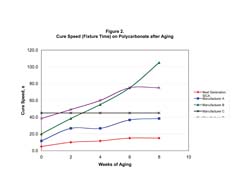
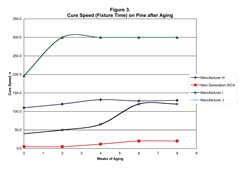
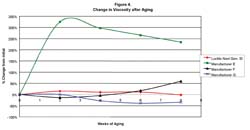
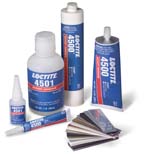
Conclusion
The data collected as part of this test indicates that next-generation SICAs offer significant improvement in fixture speed retention and viscosity stability compared to other available surface-insensitive cyanoacrylate products. Fixture speed is the most significant difference in performance, especially on pine and steel.Based on the accelerated-aging test results, the next-generation SICA formulations provide less variability in fixture speed and viscosity throughout the entire shelf life of the product. These materials also offer the fastest fixture speeds attainable in the industry on dry or acidic surfaces.
To the end user, these performance improvements mean reduced scrap, fewer inspection steps, simplified process control, more reliable and precise dispensing, fewer fixtures needed for process, a smaller processing area, and more controlled and consistent throughput.
For more information, contact Henkel Corp., 1001 Trout Brook Crossing, Rocky Hill, CT 06067; phone (800) 562-8483; fax (860) 571-5430; or visit http://www.fast.loctite.com to download the complete white paper on next generation SICAs.